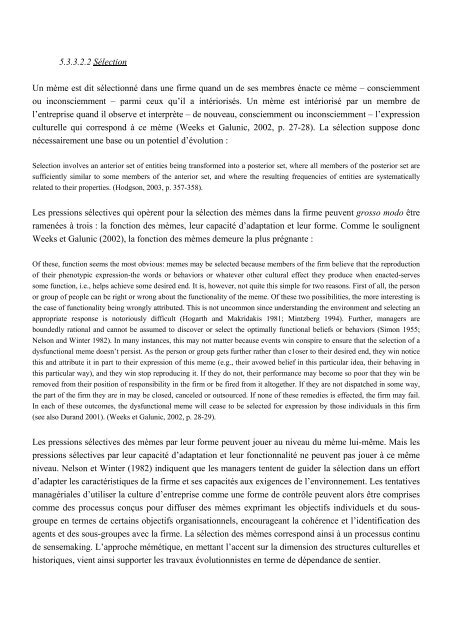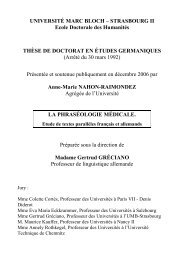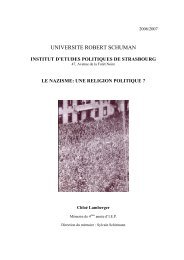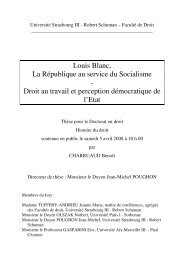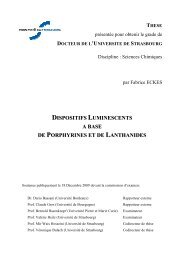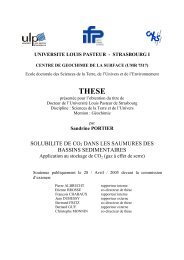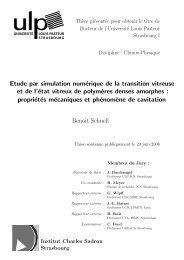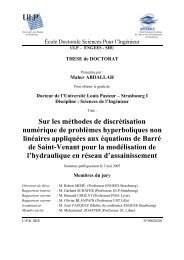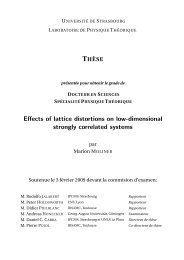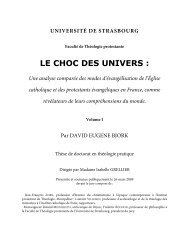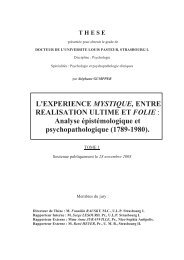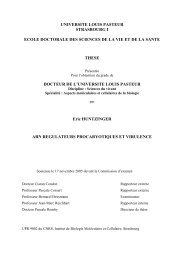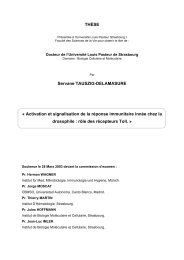Économie Évolutionniste et Culture d'Entreprise
Économie Évolutionniste et Culture d'Entreprise
Économie Évolutionniste et Culture d'Entreprise
Create successful ePaper yourself
Turn your PDF publications into a flip-book with our unique Google optimized e-Paper software.
5.3.3.2.2 Sélection<br />
Un mème est dit sélectionné dans une firme quand un de ses membres énacte ce mème – consciemment<br />
ou inconsciemment – parmi ceux qu’il a intériorisés. Un mème est intériorisé par un membre de<br />
l’entreprise quand il observe <strong>et</strong> interprète – de nouveau, consciemment ou inconsciemment – l’expression<br />
culturelle qui correspond à ce mème (Weeks <strong>et</strong> Galunic, 2002, p. 27-28). La sélection suppose donc<br />
nécessairement une base ou un potentiel d’évolution :<br />
Selection involves an anterior s<strong>et</strong> of entities being transformed into a posterior s<strong>et</strong>, where all members of the posterior s<strong>et</strong> are<br />
sufficiently similar to some members of the anterior s<strong>et</strong>, and where the resulting frequencies of entities are systematically<br />
related to their properties. (Hodgson, 2003, p. 357-358).<br />
Les pressions sélectives qui opèrent pour la sélection des mèmes dans la firme peuvent grosso modo être<br />
ramenées à trois : la fonction des mèmes, leur capacité d’adaptation <strong>et</strong> leur forme. Comme le soulignent<br />
Weeks <strong>et</strong> Galunic (2002), la fonction des mèmes demeure la plus prégnante :<br />
Of these, function seems the most obvious: memes may be selected because members of the firm believe that the reproduction<br />
of their phenotypic expression-the words or behaviors or whatever other cultural effect they produce when enacted-serves<br />
some function, i.e., helps achieve some desired end. It is, however, not quite this simple for two reasons. First of all, the person<br />
or group of people can be right or wrong about the functionality of the meme. Of these two possibilities, the more interesting is<br />
the case of functionality being wrongly attributed. This is not uncommon since understanding the environment and selecting an<br />
appropriate response is notoriously difficult (Hogarth and Makridakis 1981; Mintzberg 1994). Further, managers are<br />
boundedly rational and cannot be assumed to discover or select the optimally functional beliefs or behaviors (Simon 1955;<br />
Nelson and Winter 1982). In many instances, this may not matter because events win conspire to ensure that the selection of a<br />
dysfunctional meme doesn’t persist. As the person or group g<strong>et</strong>s further rather than c1oser to their desired end, they win notice<br />
this and attribute it in part to their expression of this meme (e.g., their avowed belief in this particular idea, their behaving in<br />
this particular way), and they win stop reproducing it. If they do not, their performance may become so poor that they win be<br />
removed from their position of responsibility in the firm or be fired from it altog<strong>et</strong>her. If they are not dispatched in some way,<br />
the part of the firm they are in may be closed, canceled or outsourced. If none of these remedies is effected, the firm may fail.<br />
In each of these outcomes, the dysfunctional meme will cease to be selected for expression by those individuals in this firm<br />
(see also Durand 2001). (Weeks <strong>et</strong> Galunic, 2002, p. 28-29).<br />
Les pressions sélectives des mèmes par leur forme peuvent jouer au niveau du mème lui-même. Mais les<br />
pressions sélectives par leur capacité d’adaptation <strong>et</strong> leur fonctionnalité ne peuvent pas jouer à ce même<br />
niveau. Nelson <strong>et</strong> Winter (1982) indiquent que les managers tentent de guider la sélection dans un effort<br />
d’adapter les caractéristiques de la firme <strong>et</strong> ses capacités aux exigences de l’environnement. Les tentatives<br />
managériales d’utiliser la culture d’entreprise comme une forme de contrôle peuvent alors être comprises<br />
comme des processus conçus pour diffuser des mèmes exprimant les objectifs individuels <strong>et</strong> du sousgroupe<br />
en termes de certains objectifs organisationnels, encourageant la cohérence <strong>et</strong> l’identification des<br />
agents <strong>et</strong> des sous-groupes avec la firme. La sélection des mèmes correspond ainsi à un processus continu<br />
de sensemaking. L’approche mémétique, en m<strong>et</strong>tant l’accent sur la dimension des structures culturelles <strong>et</strong><br />
historiques, vient ainsi supporter les travaux évolutionnistes en terme de dépendance de sentier.


